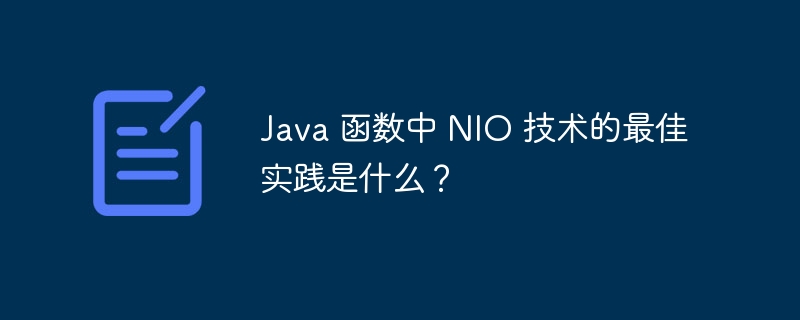What are the best practices for NIO technology in Java functions?
Best practices for using NIO functions in Java include using non-blocking mode to avoid waiting for I/O operations to complete. Use Selectors to monitor multiple channels and handle I/O events. Choose the appropriate threading model based on your application needs. Optimize buffer size to balance performance and memory overhead. Gracefully handle network errors such as connection resets or timeouts. Use SSL/TLS encryption to secure WebSocket connections.

Java Best Practices in NIO Functions
Introduction
NIO ( Non-blocking I/O) is an important technology in Java for writing high-performance network applications. By avoiding blocking operations, NIO allows applications to handle large numbers of concurrent connections while maintaining low latency and high throughput. Below we will explore the best practices in NIO functions and demonstrate them through practical cases.
Best Practices
- Use non-blocking mode: The core advantage of NIO is non-blocking operation, which eliminates waiting for I/ O required for operation completion.
- Using Selector: Selector is a core NIO class used to monitor multiple channels (such as sockets) and handle I/O events.
- Select a threading model: Select an appropriate threading model based on the needs of your application, such as a single-threaded handler or a reactor model.
- Optimize buffer size: Choosing the correct buffer size is critical for performance. Larger buffers reduce the number of system calls, while smaller buffers reduce memory overhead.
- Handling network errors: NIO allows applications to gracefully handle network errors, such as connection resets or timeouts.
- Use SSL/TLS encryption: For applications that require secure WebSocket connections, NIO supports SSL/TLS encryption.
Practical case
Start a simple NIO WebSocket server:
public class WebSocketServer {
ServerSocketChannel serverSocketChannel;
Selector selector;
public WebSocketServer() throws IOException {
// 打开服务器套接字通道
serverSocketChannel = ServerSocketChannel.open();
// 配置为非阻塞模式
serverSocketChannel.configureBlocking(false);
// 绑定到端口
serverSocketChannel.bind(new InetSocketAddress(8080));
// 创建 Selector
selector = Selector.open();
}
public void start() throws IOException {
// 将服务器套接字通道注册到 Selector,监听 ACCEPT 事件
serverSocketChannel.register(selector, SelectionKey.OP_ACCEPT);
while (selector.select() > 0) {
Set<SelectionKey> selectedKeys = selector.selectedKeys();
for (SelectionKey key : selectedKeys) {
if (key.isAcceptable()) {
// 处理 ACCEPT 事件并建立 WebSocket 连接
} else if (key.isReadable()) {
// 处理 READ 事件并读取 WebSocket 数据
} else if (key.isWritable()) {
// 处理 WRITE 事件并写入 WebSocket 数据
}
}
}
}
}This example shows how to use NIO to set up a WebSocket server and listen for client connections, reading and writing data. It applies non-blocking mode, Selector and proper event handling to achieve high performance and scalability.
The above is the detailed content of What are the best practices for NIO technology in Java functions?. For more information, please follow other related articles on the PHP Chinese website!

Hot AI Tools

Undresser.AI Undress
AI-powered app for creating realistic nude photos

AI Clothes Remover
Online AI tool for removing clothes from photos.

Undress AI Tool
Undress images for free

Clothoff.io
AI clothes remover

AI Hentai Generator
Generate AI Hentai for free.

Hot Article

Hot Tools

Notepad++7.3.1
Easy-to-use and free code editor

SublimeText3 Chinese version
Chinese version, very easy to use

Zend Studio 13.0.1
Powerful PHP integrated development environment

Dreamweaver CS6
Visual web development tools

SublimeText3 Mac version
God-level code editing software (SublimeText3)

Hot Topics
 Square Root in Java
Aug 30, 2024 pm 04:26 PM
Square Root in Java
Aug 30, 2024 pm 04:26 PM
Guide to Square Root in Java. Here we discuss how Square Root works in Java with example and its code implementation respectively.
 Perfect Number in Java
Aug 30, 2024 pm 04:28 PM
Perfect Number in Java
Aug 30, 2024 pm 04:28 PM
Guide to Perfect Number in Java. Here we discuss the Definition, How to check Perfect number in Java?, examples with code implementation.
 Random Number Generator in Java
Aug 30, 2024 pm 04:27 PM
Random Number Generator in Java
Aug 30, 2024 pm 04:27 PM
Guide to Random Number Generator in Java. Here we discuss Functions in Java with examples and two different Generators with ther examples.
 Weka in Java
Aug 30, 2024 pm 04:28 PM
Weka in Java
Aug 30, 2024 pm 04:28 PM
Guide to Weka in Java. Here we discuss the Introduction, how to use weka java, the type of platform, and advantages with examples.
 Armstrong Number in Java
Aug 30, 2024 pm 04:26 PM
Armstrong Number in Java
Aug 30, 2024 pm 04:26 PM
Guide to the Armstrong Number in Java. Here we discuss an introduction to Armstrong's number in java along with some of the code.
 Smith Number in Java
Aug 30, 2024 pm 04:28 PM
Smith Number in Java
Aug 30, 2024 pm 04:28 PM
Guide to Smith Number in Java. Here we discuss the Definition, How to check smith number in Java? example with code implementation.
 Java Spring Interview Questions
Aug 30, 2024 pm 04:29 PM
Java Spring Interview Questions
Aug 30, 2024 pm 04:29 PM
In this article, we have kept the most asked Java Spring Interview Questions with their detailed answers. So that you can crack the interview.
 Break or return from Java 8 stream forEach?
Feb 07, 2025 pm 12:09 PM
Break or return from Java 8 stream forEach?
Feb 07, 2025 pm 12:09 PM
Java 8 introduces the Stream API, providing a powerful and expressive way to process data collections. However, a common question when using Stream is: How to break or return from a forEach operation? Traditional loops allow for early interruption or return, but Stream's forEach method does not directly support this method. This article will explain the reasons and explore alternative methods for implementing premature termination in Stream processing systems. Further reading: Java Stream API improvements Understand Stream forEach The forEach method is a terminal operation that performs one operation on each element in the Stream. Its design intention is






